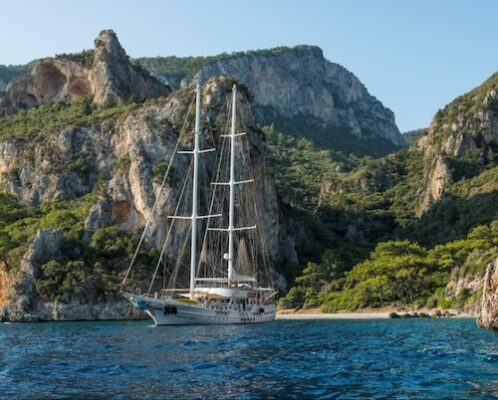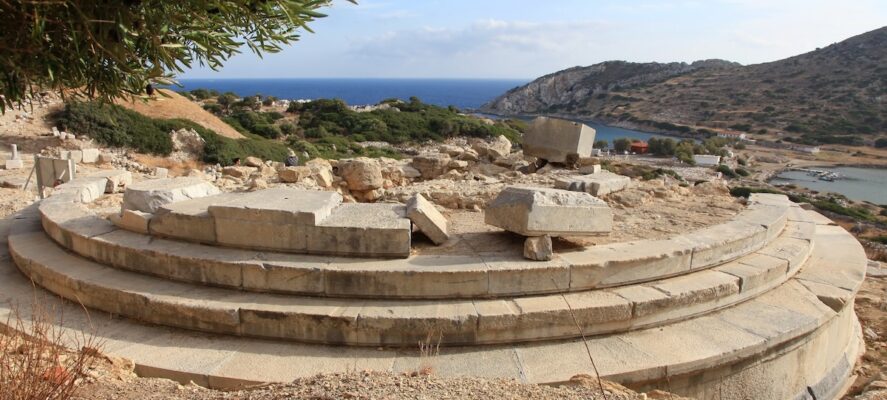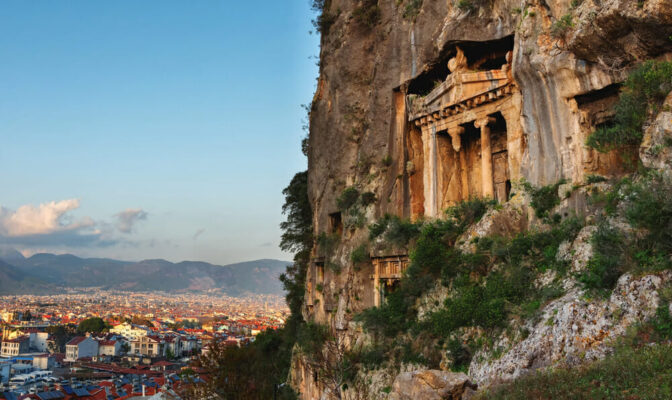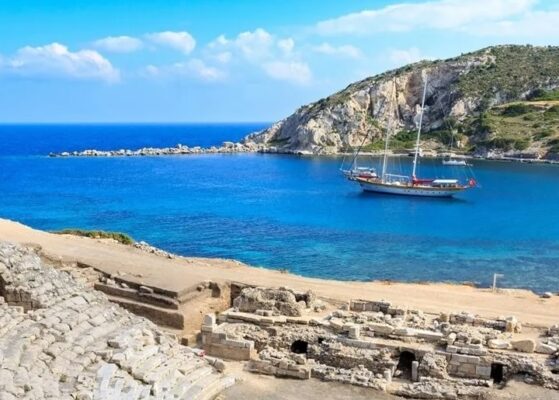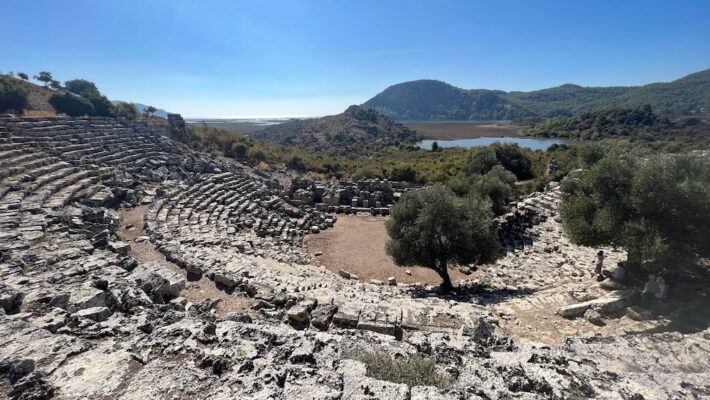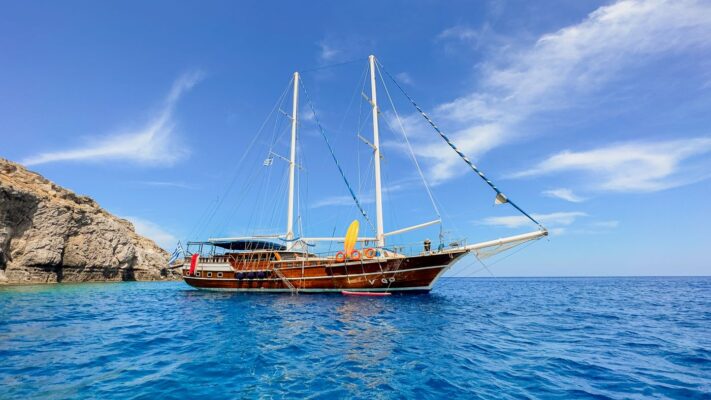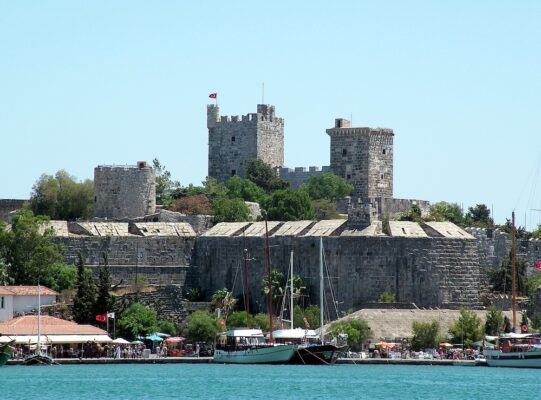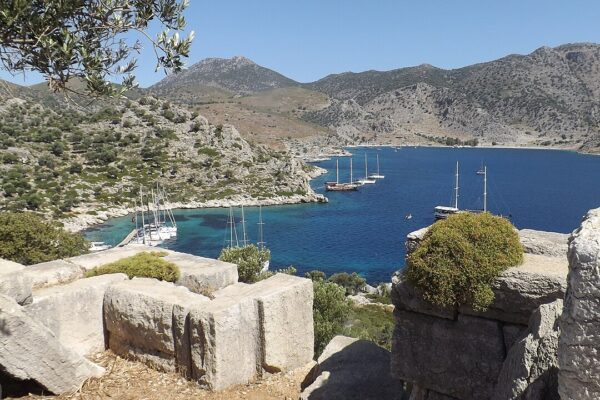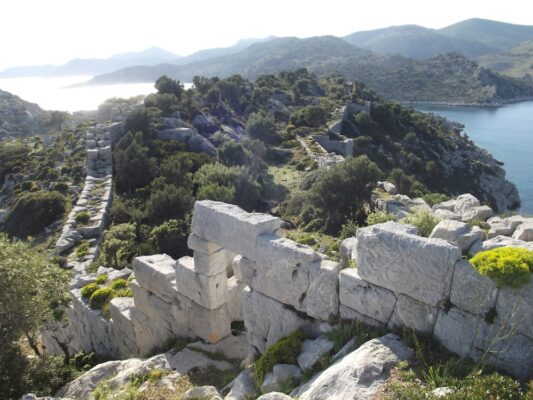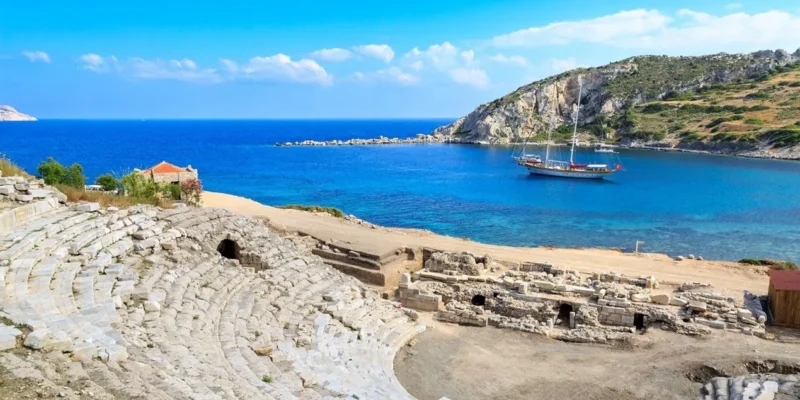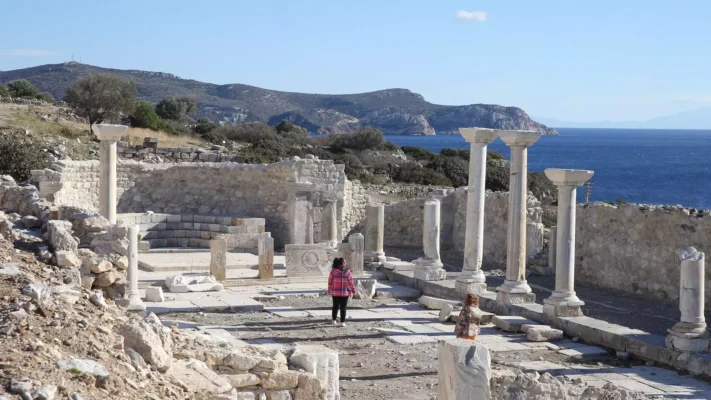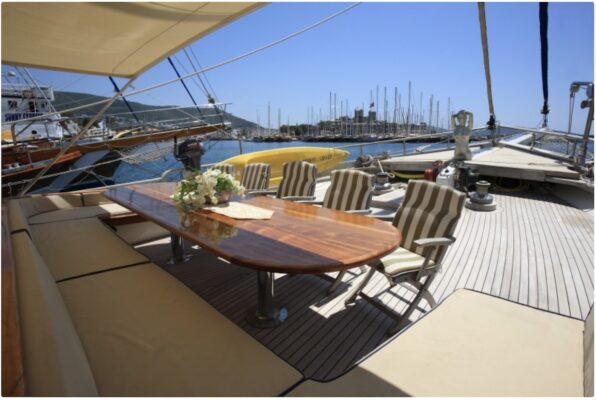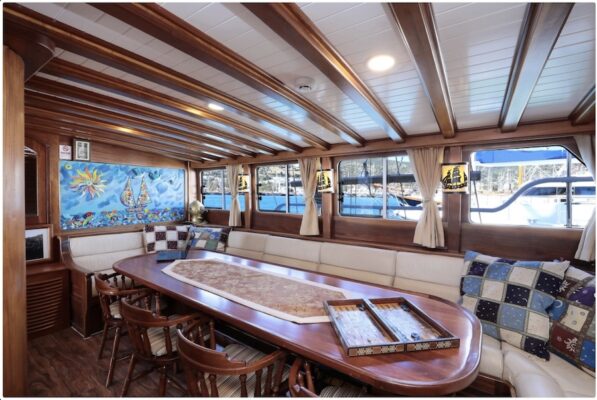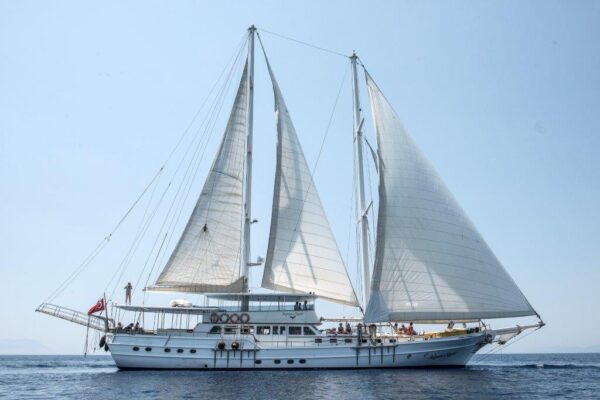Coastal Caria + Lycia
Archeology Cruise on the Turkish Coast
Cultural Program (maritime travel)
Ancient Greek archeology, Byzantine architecture, coastal towns, secluded bays, ancient Greek ampitheaters, castles of the Knights Hospitaller of the Order of St. John, swimming and snorkeling, gourmet eating and wine under the stars.
Sept. 25th - Oct. 11th, 2026
Sept, 2027
Registration: SPACES AVAILABLE (Max 17 participants)
The "Coastal Caria + Lycia: Archeology Cruise" is a 17-day cultural tour featuring two weeks cruising the "Turquoise Coast" of Caria and Lycia in the southwestern corner of Turkiye, We begin the tour in Bodrum, and end in Fethiye. Airport transfers included. The tour features pristine anchorages in secluded bays, shore visits to quaint towns and ancient Greek cities, private chef, and lectures on the maritime history of the Hellenic golden age.
On Day 3, we embark on a private gulet charter - a traditional wooden sailing ship - for our real adventure: a cruise along the famous “Turquoise coast” of the Carian and Lycian coast! Our guests absolutely love the natural beauty of this stunning coastline, with its steep arid hillsides plunging into clear blue water. Our trip takes us past several ancient cities and fortifications that were later Hellenized and Romanized in classical antiquity. Among these the Carian highlights are surely the cities of Knidos and Kaunos, the ruins of Lydae, and the necropolis of Loryma. In Lycia, we visit the church of St. Nicholas of Myra, the sunken cities of Kekova and the medieval city of Simena.
Some of these sites have never been excavated by archeologists and many remain accessible only from the sea. Onboard, we will be in the capable hands of a professional captain and crew of 5. A private chef will serve delicious freshly cooked food every meal, and we will have ample time to sip wine and look at the stars from the deck of our gulet. Many of our guests who have enjoyed our other tours will be thrilled at this opportunity. For new visitors to our company, please see our review page for a sense of what to expect. Read more about the program below!
Details:
- Arrive: Bodrum International Airport (BJV).
- Depart: Dalaman International Airport (DLM), transfer from Fethiye.
- 17 day trip (2 nights Bodrum, 14 nights on private charter boat, optional night in Fethiye on Day 9 and/or at the end of the tour)
- Visas: US passport holders do not need a Turkish visa.
- Maximum 17 guests (only a deposit secures a place on tour).
Tour Leaders:
- John Graham
- Invited specialists
Accommodation:
- Best available boutique hotels, gulet charter.
Brochure:
- Contact us for the invitational tour brochure and registration form. Email: admin@johngrahamtours.com
Registration:
- Submit registration form (sent at your request)
- Send deposit of $2000 to secure your place (details in registration form)
Castles of Caria-Lycia tour route:
Fees (2026):
- Coastal Caria-Lycia tour fees are detailed in the tour brochure. Please email us for a copy!
- Inquire about $300 discount for the Coastal Caria-Lycia tour if you have been on a previous tour with JohnGrahamTours!
Payment Methods:
- Bank transfer (preferred)
- Credit card via Paypal (3% Paypal charge applies)
Pre/Post-Tour Options
- While we are not offering extension trips ourselves, we recommend an extra day in Bodrum before the trip, or a day or two in the nearby resort of Oludeniz after the tour (airport transfers provided). After the tour, if you would like to continue independent travel, we recommend staying two more nights in Istanbul, which is a fascinating city that we will not have time to explore on our main itinerary.
Included:
- Accommodation in high quality boutique hotels in Bodrum and (optionally) in Fethiye.
- Cabins as described in the itinerary on the gulet charter (we email photos).
- All ground transportation including airport transfers.
- All meals with wine.
- All museum and site entrances.
Not Included:
- International airfare.
- Tips for primary guide and gulet crew (see details in brochure).
- Personal services (laundry, etc.).
- Personal bar tab on the gulet.
- Travel insurance (required).
Mobility-Fitness:
- Standard: 4/10 on the mobility scale (10 being the most demanding).
- General fitness required. The boat has narrow passageways with steep staircases. While the shore excursions are optional, those that come should be prepared for trails on rocky terrain in warm weather.
- While the boat is cruising, balance is required when moving around the boat.
Special Notes:
- Architectural focus, historical focus from a maritime perspective.
- Wine and cuisine.
- Exceptional natural landscapes, as seen from the sea.
- Swimming, kayaking, and water sports.
Weather:
- We will expect late fall weather on the Mediterranean in late October with temperatures in the 70s F, going down into the 60s at night. While it usually does not rain in this season, we will expect a few cloudy days, which will be perfect for shore explorations. In the afternoons, the wind could pick up, so a long sleeve shirt or windbreaker might be desirable. The cabins have air conditioning units, but these are unlikely to be necessary.
Packing:
- There is limited space on the boat, so please pack light. One medium suitcase maximum. Soft bags that can be stowed in closet spaces preferable.
- Comfortable walking shoes for shore excursions through towns and around archeology sites.
- Sunhats, sunscreen, sun-glasses, swimsuits, personal swimming goggles and flippers, etc.
- The gulet comes with paddle boards and kayaks.
Overview
We are excited to welcome our guests to our new 17-day archeology and cruising program, "Coastal Caria + Lycia" We will travel aboard a gulet charter cruise for an adventure exploring the coastlines of Turkiye. This has been a maritime highway for millennia, with the shipwrecks, ancient cities, and ambiance to prove it!
It is impossible to see everything in one trip, yet this trip packs in a number of the significant sites while maintaining a decidedly leisurely pace. Daily cruising time never exceeds 4 hours per day. Some days we will be in ports exploring what is on offer on shore, while other days we will anchor in secluded bays enjoying the peace of the stars and the waves. With a fantastic chef and plenty of gourmet Turkish red wine on board, every evening will be a special night out under the stars.
September-October is the perfect time to cruise these coasts, as the water temperature is still warm enough to enjoy a swim at any time day or night, but the extreme temperatures of the summer have worn off. Still, the dramatic winds of the Aegean will not have arrived yet, and sailing should be relatively calm.
Our captain has 40 years experience sailing these waters, and this is his own private wooden ship. He and his crew of 4 keep the boat spotlessly clean, while also attending to our guest's every need. Come and relax with us, while we enter the world of ancient Greek maritime travelers.
Historical-Cultural view
The “Coastal Caria + Lycia” tour is so named because this region of southwestern Anatolia was once inhabited by the Carian and Lycian peoples, attested in many ancient Greek sources. We explore various layers of history, including its bronze-era ancient seafaring past (1000-2000 BC), its Greek golden era (500-100 BC), churches from the Byzantine “late antique” period, and the prominent 14th – 15th century crusader fortresses left by the retreating Knights Hospitaller (St. John’s Order of the Knights of Malta).
The jutting peninsulas that stretch into the Aegean Sea are precipitously mountainous, making travel by land nearly impossible even today and rendering many areas accessible only be sea. But this terrain also provided plentiful safe harbors for seafarers traveling from Egypt and Canaan to the Greek city states and beyond. The evidence for this vibrant trade route is discovered in one of the best underwater archeology museums in the world, housed in the historic fortress in Bodrum and one of our key destinations in the first days of our tour. Within this museum, we learn about the trade goods of sea merchants from as early as 1300 BC whose ships were wrecked on the Carian coast but have been recovered piece by piece using advanced diving equipment in the modern era.
The Carian people were a mainland tribe who had their own language and alphabet, but established trade and political ties with various Greek entities. For example, king Mausolus of Halikarnassos was a satrap of the Persian Achaemenid empire but hired Greek architects from Priene to build his magnificent burial chamber. The resulting structure gave the name “mausoleum” to all future extravagant tombs because of its immense structure and incredibly ornate carvings. Some of the blocks of this mausoleum were used in the construction of the harbor fortress by 15th century knights, while many of the carved statues and panels are housed in the British Museum. There is also an ancient Greek theater preserved in the hillside above the Bodrum bay, and various remnants of a large defensive wall structure from that period.
In Lycia, we will visit the sunken cities at Kekova island, and the church of St. Nicholas of Myra, among other highlights.
Travel Program
We begin our tour in the ancient city of Halicarnassus (modern Bodrum), exploring it's ancient streets, Greek ruins, and the crusader fortress that dominates the entrance to this valuable harbor. In ancient times and was an important cultural center and birthplace of distinguished figures such as Herodotus, the “father of history.” The port has proved vital throughout the millenia with remnants of past empires dotting its protected bay; the tomb of Mausolus (built around 350 BC) was considered one of the seven wonders of the world. Alexander the Great assaulted the castle, such was its importance in his era. On our day in Bodrum, we will explore the 15th century Castle of St. Peter built by the Knights Hospitaller in the 15th century, a huge fortress above the bay that now houses the Underwater Archeology Museum. This unique museum features a dizzying array of incredible artifacts excavated from ancient shipwrecks along the Carian coast.
After embarking on our gulet on Day 3, we’ll cruise across the bay to the Datca peninsula, where we explore the city of Knidos, one of the archeological highlights of the tour. This city with shrines to Aphrodite and Apollo was the center of the confederation of states called the Dorian Hexapolis in the 4th century BC. With its sandy isthmus between rocky shore and island, it was famous for two protected bays at opposite points of the wind. Thus, ancient seafarers awaiting favorable winds would often stay for many days worshipping at the city’s major shrine dedicated to Aphrodite, and reputedly visiting the city’s equally famous porneio. Today, the hillside is littered with the remains of hundreds of buildings and marble shrines, making it easy to imagine an incredible city with sea views in every direction. A theater and agora dominate the lower structures along the shore, while the shrine sites are situated further up the slope.
The ancient settlement of Loryma offers another chance to scramble up the rocky hillside from the coast in order to discover the walls of a necropolis that look directly across the straits to the island of Rhodes. In 395 BC, the Athenian general Konon assembled a fleet of some 90 ships in this bay for an invasion of Rhodes. But that shouldn’t be considered ancient: archeological surveys have discovered that this bay has been inhabited since at least 5000 BC.
The ancient fortification of Lydae; the destination of our first archeological exploration. This ancient Carian-Lycian city, as yet unexcavated due to its inaccessible position from land, is located in a bowl atop a rocky peninsula in a hidden position. From this vantage point, which is still only accessible by sea, it could look over the surrounding sea in three directions. For those intrepid enough to climb 30-40 minutes uphill, we are rewarded with the suggestion of a large and complex city ruin, unexcavated, in the way it has been for thousands of years. Even so, we can ascertain the locations and remains of a Greek theater, a Roman agora, and monumental Roman tombs from the local family who appear to have been important members of Roman society. Inscriptions on several tombs give us their name: Caius Julius Heliodorus, to give one example. Discovered in the 1880s by Theodore and Mabel Bent, not much has changed since their first descriptions of the place as “a paradise for archeologists and tortoises.”
Our visit to the enormous city of Kaunos will be one of the archeological highlights of the trip. Our approach is by boat through a silted-up delta which used to be the port. As we approach, we see an impressive array of tombs carved into the cliffsides, a mixture of monumental Persian tomb carving but with Ionian Greek columnar architectural features suggesting the range of cultural influences in this region. In the city itself, we find all the elements of a prosperous city in antiquity: the theater, the agora, shrines to the Gods, tombs for the elites. There is also an infrequently visited but well-preserved Byzantine church from the late 6th century AD, which offers the chance to discuss the ways in which Christianization affected cities throughout the Byzantine Empire. We often encounter layers and layers of history in each site with the earliest remains reflecting the local Carian people, followed by Greek and Roman monumental structures, and finally Byzantine churches.
By Day 9, we arrive at Telmessos (modern Fethiye), an important port city with the remains of an ampitheater and several tombs. Nowadays the town is charming yachting port and tourist starting point for walkers on the Lycian Way 500km trek, para-gliding, and other sports. It is good for a day’s walk around, with the still-functioning 16th century Ottoman bath house a popular site. We will disembark for the day here (optional overnight stay at a nice hotel) while our gulet crew restocks the boat for the second half of our trip.
Along the Lycian coast, we visit classic sites such as the sunken city at Kekova island, the medieval city of Simena, the cities of Xanthos and Patara, and the church of St. Nicholas at Myra. The anchorages and swimming are superb!
The charter boat
The boat is a double-masted ketch style gulet, measuring 135 feet long, skippered and owned by a captain who has over 40 years’ experience sailing these coastlines (his grown children are also skippers in their own right!). I think it’s important that he skippers his own boat, so he knows every detail about its engine and water systems. The captain also knows all the most favorable anchorages, whether we are at port or in a secluded bay. The boat features 11 cabins for potentially 22 guests (in addition to 5 crew) and features a variety of common spaces both shady and sunny, forward and aft, indoor and outdoor, and a very nice bar space. There are even some sunning cushions on the upper solar-panel deck which were placed specially, according to the captain, for French clients who insisted on nude sun-bathing. The point is this boat has a lot of common space to find a conversation corner or a quiet corner. My plan is to limit our group to 17 people rather than fill the boat to capacity, thus giving us the luxury of even-more deck space.
The beds have good quality mattresses, and each cabin features a private bath/shower. The boat is older than others we saw (built in 2000) with less shiny trim, but the boat features solid teak cabin doors, a strong hull, classic portal windows, and the captain spends his life either sailing or upgrading the boat. For example, while inspecting the boat in dry dock last week, he was in the process of repainting the hull and replacing every air-conditioning motor on the boat (each room has an individual air conditioner, which are especially needed for cruises in July and August). I found that the sleek new gulets are extremely over-priced for what one gets, which is essentially the same-sized cabins and the same amount of deck space. The newer boats feature jacuzzis on the deck, private television sets in each room, shiny metal/glass trim etc but for my eye, don’t justify double or triple the rental expense.
In summary, I’ve chosen the older, well-maintained boat at a reasonable cost, skippered by the owner himself, with extra deck space which I’ll further maximize by limiting our total group size.
Request the full brochure! Email: admin@johngrahamtours.com
Tour Locations:
Bodrum
+ In Bodrum, where we end our tour, we visit the Halikarnassos mausoleum ruins, one of the seven wonders of the ancient world. We also visit the impressive 15th castle of the Knights Hospitaller, which houses the world famous museum of Underwater Archeology. Each tower in the castle is a museum exhibit featuring one or more ancient shipwrecks that have been meticulously excavated from the nearby seabed. The finds are absolutely extraordinary!
Carian coast of Turkiye
+ We will visit the remnants of the Ancient Greek city of Loryma above the Bozukkale bay, then enjoy exploring the intricate coastline of secluded bays and inlets. We will visit small artist towns like Bozburun and Selimiye and Datca, and on the last day, spend a significant time touring the well-preserved double-harbor ancient Greek city of Knidos.
Lycian coast of Turkiye
+ We will visit the remnants of the Ancient Greek sunken city at Kekova island, the medieval city of Simena, the Greek cities of Xanthos and Patara, and the early Byzantine church of St. Nicholas at Myra. The anchorages and swimming are superb!
Fethiye
+ We visit the port town of Fethiye mid-tour for restocking, then return for disembarkation. This charming town, which in ancient times was called Telmessos, merits exploring the ampitheater, tombs, and other ruins that can still be viewed near the old port. We spend half a day on our tour, but we recommend an extra night at the end of the tour to best experience the town.
Request the full brochure! Email: admin@johngrahamtours.com
